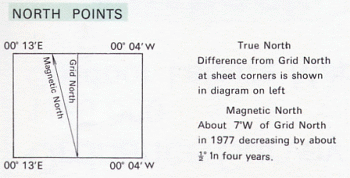Help topics
- Purpose of the site
- Compass features
- Compass menu
- Compass or GPS - advantages and disadvantages
- Compass Test
- Draw a single or multi-legged route
- Extending the compass direction of travel arrow
- False readings when using a compass
- Fine Tuning the Set Compass
- Getting started with Set Compass
- Google Maps projection
- GPS or Compass - pros and cons for navigation
- Grid references test
- How to use a compass
- Import Google Map routes
- Latitude and longitude positions: degrees, minutes and seconds
- Magnetic declination or variation
- Magnetic declination or variation adjustment
- Magnetic declination or variation calculation
- Map projections
- Map reading
- Map reading skills test
- Menu
- Moving the Set Compass
- My Google Map Compass Routes
- Negative magnetic declination or variation
- New Features
- North: different types
- North on Google Maps
- Ordnance Survey Compass
- Ordnance Survey maps integration
- Ordnance Survey map projection
- Ordnance Survey map symbols
- Panning and Zooming with Google Maps
- Positive magnetic declination or variation
- Print Map Function
- Route drawing
- Route Information Display
- Safety
- Save and Store Set Compass Google Map Routes
- Single leg or multi-legged routes?
- Test your compass reading skills
- Tips
- Types of bearings
- Updates
- User Guide
- Watch as Compass
- What is a compass?
- What type of compass is used on the site?
- Zooming with Google Maps
Google Maps Projection

When features on the curved surface of the Earth are represented on a flat surface, their shape or size will always be subject to distortion in one way or another. Methods for representing these features on paper are known as map projections.
Google Maps use a Spherical Normal (equatorial) variant of the Mercator projection for its map images. The Mercator map was developed in 1569 by Gerardus Mercator as a navigation tool based on a rectangular grid with parallel lines of latitude and longitude. The Mercator map was designed as an aid to navigators since straight lines on the Mercator projection are loxodromes or rhumb lines - representing lines of constant compass bearing - perfect for 'true' direction.
The Mercator projection exaggerates the size of areas far from the equator. For example, Greenland is presented as having roughly as much land area as Africa, when in fact Africa's area is approximately 14 times greater than Greenland. Google Maps cannot show the poles as the Mercator projects them at infinity. Instead it cuts off coverage at 85° north and south.
The first launch of Google Maps did not use Mercator, and streets in high latitude places like Stockholm did not meet at right angles on the map the way they do in reality. While the Mercator projection distorts a 'zoomed-out view' of the world, it allows close-ups (street level) to appear more like reality because it preserves street angles.
True North on Google Maps is not shown, but for a normal Spherical Mercator projection, grid north and true north will coincide and it will follow any vertical line (or meridian) to the top of the map.
Ordnance Survey Map Projection
Ordnance Survey maps are based on a similar type of map projection to Google Maps called the Transverse Mercator Projection which is designed to keep the unavoidable distortions within acceptable limits. The Transverse Mercator Projection is especially suitable for the UK, a country with its greatest extent in a north-south direction. Grid north and true north do not coincide, with variation smallest along the central meridian (vertical line) of the map, and greatest at the map edges. This variation is illustrated below in an extract from an Ordnance Survey map key.
Google Maps use a Spherical Normal (equatorial) variant of the Mercator projection for its map images. The Mercator map was developed in 1569 by Gerardus Mercator as a navigation tool based on a rectangular grid with parallel lines of latitude and longitude. The Mercator map was designed as an aid to navigators since straight lines on the Mercator projection are loxodromes or rhumb lines - representing lines of constant compass bearing - perfect for 'true' direction.
The Mercator projection exaggerates the size of areas far from the equator. For example, Greenland is presented as having roughly as much land area as Africa, when in fact Africa's area is approximately 14 times greater than Greenland. Google Maps cannot show the poles as the Mercator projects them at infinity. Instead it cuts off coverage at 85° north and south.
The first launch of Google Maps did not use Mercator, and streets in high latitude places like Stockholm did not meet at right angles on the map the way they do in reality. While the Mercator projection distorts a 'zoomed-out view' of the world, it allows close-ups (street level) to appear more like reality because it preserves street angles.
True North on Google Maps is not shown, but for a normal Spherical Mercator projection, grid north and true north will coincide and it will follow any vertical line (or meridian) to the top of the map.
Ordnance Survey Map Projection
Ordnance Survey maps are based on a similar type of map projection to Google Maps called the Transverse Mercator Projection which is designed to keep the unavoidable distortions within acceptable limits. The Transverse Mercator Projection is especially suitable for the UK, a country with its greatest extent in a north-south direction. Grid north and true north do not coincide, with variation smallest along the central meridian (vertical line) of the map, and greatest at the map edges. This variation is illustrated below in an extract from an Ordnance Survey map key.

Ordnance Survey map showing Grid North, Magnetic North and True North variations for Purbeck UK, 1977
Copyright © 2009 - 2025 All Rights Reserved
Barcelona Field Studies Centre S.L.
Barcelona Field Studies Centre S.L.